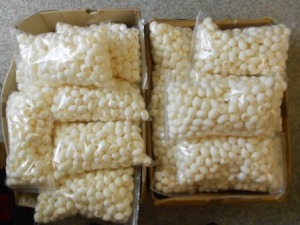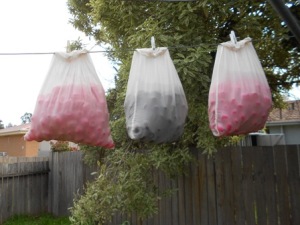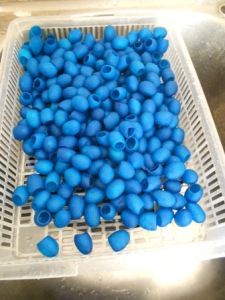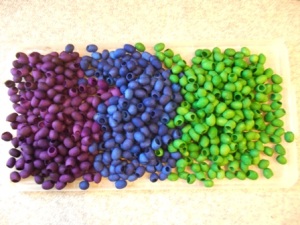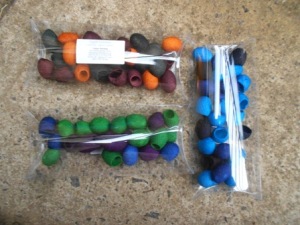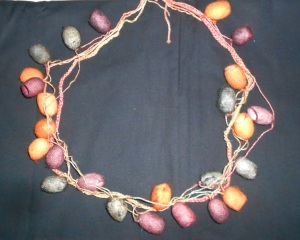I have been dyeing various silk products for over ten years now and never cease to be amazed at how well the colour is absorbed by the silk fibre. Each different silk ‘bit’ has different dye absorption – more or less dye sites for the dye to lock onto and each, therefore, is a little bit different, even when dyed in the same dye bath.
Silk fibre is an animal or protein fibre, so generally would be dyed most effectively with acid dyes. These dyes need to be boiled or steamed to create the reaction and to set the dye. That does not work with the cocoons very well as a cocoon still contains the sericin – the protein that makes the cocoon hard and strong. When cocoons are processed into silk fibre, they are boiled or at least softened in very hot water to break down the sericin and release the fibre, ready to be spun. If the hard cocoons are boiled or heated extensively in the dyeing process, there is a strong likelihood that the cocoon will loose the sericin and thereby damaged. For this reason, I use Procion dyes which are generally optimal for cellulose or plant based fibres, but work well on silk too. Procion dyes are a cold water process so the risk of breaking down the sericin is almost non existent. You may often read that you need to use an acidic mordant with the Procion dyes on silk, but I still use soda ash – an alkaline and it works fabulously. Here are some photos and a brief description of my process.
I get these in big boxes, by the kilogram. They are not yellow, this was a product of the flash on the camera. The cocoons come cut. This means that the original occupant is no longer in situ, which is a good thing. Cut cocoons clear customs much faster than uncut ones and are generally cleaner, though you pay more for them due to the processing. Once I have these, I work out how many colourways I need to dye and how much, weight wise, required to dye each colourway. I then take the cocoons and weigh them into bags: one bag per colour needed. My cocoons are sold in mixed packs of three colours, so what ever I do needs to be divisible by 3. In the case of this dye run, I needed to do ten colour ways, so 30 different colours in total, so 30 different bags of cocoons.
I mix my dyes and pour them into each bag, sealing the bags as I go. Each bag gets about a litre of dye and I move it around to try to give all the cocoons a fairly even coverage. Consistency in colour and coverage is not essential to me in this process, but I do like them all to be well coloured and the colour saturated.
After the dyeing and batching is completed, I rinse them in warm water until the water runs clear. When the rinse water is clear, it indicates that all of the dye molecules are either permanently locked into the silk fibre cells or flushed out in the rinse water. Here are some of my colours soaking.
If you look closely, you can see that they are in sets of three as I try to keep my colourways together.
I dry these one of two ways, sometimes in a combination of both. Firstly, if the weather is good, I put them in fabric bags and hang them on the line, again keeping the sets of three together as best I can.
If weather and space allows, depending on how much I have dyed, I spread the cocoons out in baskets, on netting and even on old screen doors to dry. This takes up a lot of space if I do all the colourways and will only work on warm, dry days. It is not uncommon for every horizontal space in the house to be covered with trays of drying cocoons when the weather won’t play nicely with me.
Once completely dry, I combine the three colourways in a big tub, remove knotted or loose silk fibre and give them a big mix.
This is the “Cools” colourway. From there, they are weighed very carefully into 10 gram lots and packaged into either cellophane bags or clear pillow packs. Every pack is a little bit different. They are not easy to photograph in the pillow packs, but they look terrific like this.
I get asked constantly what to do with them. Well, the short answer is anything your feel like. You can stitch onto and through them, so they can be embellished and sewn to anything, strung up or added to pretty much any project that you think would benefit from three dimensional elements. Try embroidering or beading into them, adding them to embroidery or felt projects, turning them into flower buds, snails, fairy skirts, and so much more. Add them to collage or sculptures, or like the example below, make jewellery. There is no limit to how you can use them; only a lack of ideas. Here is a very simple necklace I made.
I have fifteen different colourways, all of which are on my website – http://www.uniquestitching.com.au. Search for cocoons if you want to have a look.

